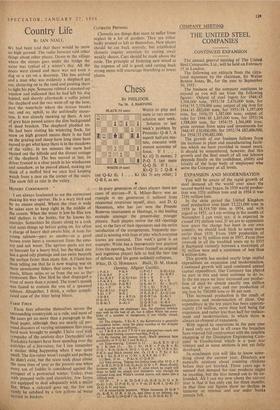Chess
By PHILIDOR
No. 34. J. HARTONG WHITE (9 men)
BLACK (11 men) WHITE to play and
mate in two moves: solution next week.
Solution to last week's problem by Promislo: Q-B 7. A superb half-pin mu- tate, executed with utmost economy of force. If 1 . . . Kt (Q 3) moves; 2 P-Q 5 (set mate Q-Q 5). If 1 . . Kt-Q 2; 2 Q-B 4 Kt (Kt 3) any other; 2
15RxR QxR
16 K-Kt 1! Kt x Kt (f)
17 B x Kt P-B 3 18 Q-Q 2! Q-R 3?
19 R-K B I I Kt-Q 2 (h)
20 12:-B 7 ch K-Kt 3
21 Q-B 2 PxB
22 Q-B 5 ch K-R 4
23 R-R 7 Resigns (I)
(a) Accepting the challenge: this, the classical defence, may well be the best of all, but it offers White the possi- bility of a number of dangerous, if not wholly sound, 'Packs. (b) The Allgaier. 5 Kt-K 5, the Kieseritzky is generally considered better, since the piece sacrifice in the Allgaier should not be quite sufficient.
(c) 7 B-B 4 ch and 7 P-Q 4 are alternatives—each met by the same freeing counter-sacrifice. P-Q 4. (d) By forcing the bishop back, ,Black prevents later possibility of P-Q Kt 3 and B-Kt r. (a) Time-wasting. Correct is 12 . . . Kt-K II 31 If 13 R x B, then 13.. . . Kt x Kt; 14 R X P ch, B x R; 15 Q x B ch, Q-Kt 4; 16 Q x Q ch, P x Q: 17 B x Kt, P-B 3; and Black should win. 0. 13 B x P, Kt x Kt;
14 B x Kt, R-B 11 or 13 Kt x K B P, Kt X PI (f) Best. If 16 . P-Kt 6; 17 Q-B 3! (g) Very strong. Taking the bishop loses after 19 Q x P ch. K-R 2; 20 Q-R 5 ch, K.-Kt 2; 21 Q x P. Black should, however, reply 18 K-Kt 31. after which he might still hope to hold the attack and ultimately win, • though his exposed king and White's central pawns will make this difficult task.
(h) 19... P x B; 20 Q-B 3 ch, K-R 2; 21 Q x B, Q-Kt 3 at; 22 P-Q 41, Q x P ch; 23 K-R 1, Q-Kt 21;
24 Q-K 81 and wins.
(I) A remarkable position. White threatens 24 Q-B 7 ch, K-R 5; 25 R x 'Q di, and there no defence, e.g. 23 ... Kt-B I; 24 Q-B 7 eh, Kt-Kt 3 28 Q-K Kt 7! (set Q-Kt 8). 1 . . . Q-B 8, as set.
In every generation of chess players there are cases of atavism—P. S. Milner-Barry was an example in my generation (I suffered from occasional reversions myself, also), and D. G Horseman, who has just won the Premier Reserves tournament at Hastings, is the leading example amongst the present-day younger players. Such players revive the old openings and, to the fury of their opponents and the entire satisfaction of the unregenerate, frequently suc- ceed in winning with lines of play which everyone knows are unsound. This week's game is an example: White has a theoretically lost position from the opening, but Home (himself an original and ingenious player) fails to find the best line of defence, and his game suddenly collapses. White, D. G. HORSEMAN Black, D. M. HORNE
Opening, Allgaier Gambit.
1 P-K 4 P-K 4 12 P-Q 3 a-Kt 4 (e)
2 P-KB4 PxP 13 B x P Kt-K B3 3 Kt-K B 3 P-K Kt 4 (a) 14 11 x 13 11 x 13 4 P-K R 4 P- Kt 5 Kt-Kt 5 (b) P-K R.3
Kt-B 3 6KtxP K P-xK 7 (c) PQ 4t
8 Kt x P B-K. 2 913-B4 B x RP ch 10 K-B I P-Kt 4(d) 11 13-Kt 3 K-Kt 2










































 Previous page
Previous page